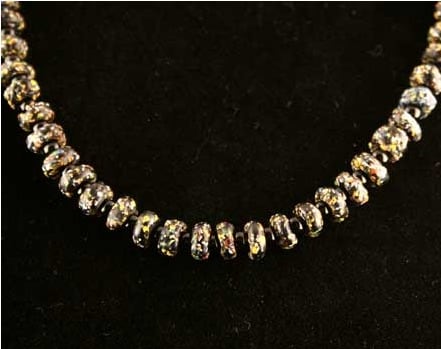Islamic Glass Bead and Onyx Bead Necklace, 800 CE - 1200 CE
Glass and Onyx
FJ.7296
This necklace is composed of genuine Ancient Islamic glass beads dating from 800 A.D. to 1200 A.D. and modern onyx beads. It is clear that Ancient Islamic craftsman considered creating...
This necklace is composed of genuine Ancient Islamic glass beads dating from 800 A.D. to 1200 A.D. and modern onyx beads.
It is clear that Ancient Islamic craftsman considered creating glass beads for necklaces an art form since the Muslim world places such high priority on design, beauty and harmony of colors. Within the Islamic world, beads serve as status and symbols, and the role of beads in Islamic cultures have been enhanced by the importance accorded to circles and spheres in medieval Islamic thought. For the Muslim, the circle is the primary cosmological symbol, one of whole unity. From the basic circle and a hexagonal arrangement of tangential circles of the same radius surrounding it, three primary shapes emerge: the triangle, the hexagon, and the square. As to embody such thought of religious and cultural philosophy, this necklace consists circular beads. Against the black background, a range of speckled colors from white and yellow to red and blue enliven the beads.
A gem of contrasts, onyx is chalcedonic quartz frequently layered in different shades of contrasting color, most commonly polar opposites of black and white. Found in both the Old and New worlds, onyx was used by the Classical Greeks and Romans to carve cameos and other personal jewelry, and by the tribes of ancient Mexico to make masks and sacred ritual objects. Alexander the Great particularly favored onyx and many small cameo portraits of him survive from antiquity, when they were thought to bring good fortune of this fable ruler to the wearer. The gem is mentioned in the Old Testament Book of Exodus as figuring prominently in the breastplate of the High Priest. Its lustrous, rich polished surface—usually of deepest ebony black, rich green, or very pure white—makes it highly desirable stone for modern jewelry. The chief virtue of onyx as an amulet is that it seems to attract and absorb negative humors from the body of the wearer, causing relief from both physical pain and mental anxiety. Black onyx is especially thought to have unique properties, as black suggests both the presence of all colors and the absent of light. For that reason, it serves as a buffer from pain, a defensive wall against evil and illness.
It is clear that Ancient Islamic craftsman considered creating glass beads for necklaces an art form since the Muslim world places such high priority on design, beauty and harmony of colors. Within the Islamic world, beads serve as status and symbols, and the role of beads in Islamic cultures have been enhanced by the importance accorded to circles and spheres in medieval Islamic thought. For the Muslim, the circle is the primary cosmological symbol, one of whole unity. From the basic circle and a hexagonal arrangement of tangential circles of the same radius surrounding it, three primary shapes emerge: the triangle, the hexagon, and the square. As to embody such thought of religious and cultural philosophy, this necklace consists circular beads. Against the black background, a range of speckled colors from white and yellow to red and blue enliven the beads.
A gem of contrasts, onyx is chalcedonic quartz frequently layered in different shades of contrasting color, most commonly polar opposites of black and white. Found in both the Old and New worlds, onyx was used by the Classical Greeks and Romans to carve cameos and other personal jewelry, and by the tribes of ancient Mexico to make masks and sacred ritual objects. Alexander the Great particularly favored onyx and many small cameo portraits of him survive from antiquity, when they were thought to bring good fortune of this fable ruler to the wearer. The gem is mentioned in the Old Testament Book of Exodus as figuring prominently in the breastplate of the High Priest. Its lustrous, rich polished surface—usually of deepest ebony black, rich green, or very pure white—makes it highly desirable stone for modern jewelry. The chief virtue of onyx as an amulet is that it seems to attract and absorb negative humors from the body of the wearer, causing relief from both physical pain and mental anxiety. Black onyx is especially thought to have unique properties, as black suggests both the presence of all colors and the absent of light. For that reason, it serves as a buffer from pain, a defensive wall against evil and illness.
